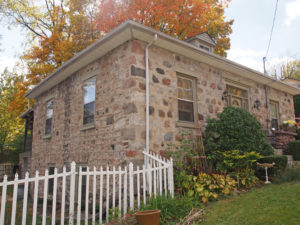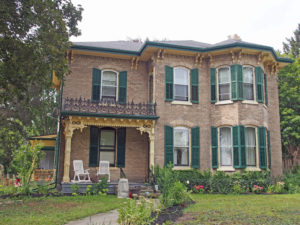Paris, Ontario – Book 1 in Colour Photos – My Top 13 Picks
Paris, Ontario is located on the Grand River. It was first settled by Hiram Capron a native of Vermont who, in 1822, emigrated to Norfolk County where he helped to establish one of Upper Canada’s earliest iron foundries. He settled here at the Forks of the Grand (where the Grand and Nith Rivers meet) in 1829, divided part of his land into town lots, and in 1830 constructed a grist-mill and named the town after the gypsum deposits that were mined nearby. Gypsum is used to make plaster of Paris. The town of Paris is often referred to as the “cobblestone capital of Canada†because of the many cobblestone buildings that are still standing.
Paris is home to thirteen cobblestone buildings. Mason Levi Boughton inspired Paris’ cobblestone technique in the mid to late 1800s. It is estimated that over 14,000 cobblestones were required to build one traditional farmhouse. Each cobblestone is about the size of a sweet potato. Cobblestone architecture refers to the use of cobblestones embedded in mortar to erect walls of houses and commercial buildings.
Levi Boughton was born in Normandale, New York in 1805. He came to Brantford, Ontario in 1835 and in 1838 he moved to Paris. He brought the cobblestone craft to Paris. The cobbles are fist-sized rocks. Boys were paid ten cents a day to walk beside a sled pulled by oxen and throw cobbles turned up by ploughing into the sled. Mortar is laid in horizontal courses with cobbles framed with mortar joints. Cobblestone walls use lime mortar which is a mixture of lime and sand. Lime mortar sets slower, is more elastic and easier to work with than cement-based mortars. Because lime mortars are porous, relatively soft, and have low tensile strength, corners and wall openings in cobblestone structures are strengthened by rectangular blocks of stone called quoins. Window sills and lentils were also reinforced.

22 Church Street – Dr. Alfred Bosworth and his wife Sarah built their home in 1845. It is in the Queen Anne Regency style and has cobblestones on the front and south facades and cut fieldstones on the other two sides. In 1870, Reverend and Mrs. Thomas Henderson were living in the house. Originally from Scotland, Rev. Henderson wrote to his friends the Bell family and advised them to come to Canada for a healthier environment for their son Alexander Graham Bell.

40 Dumfries Street – pre 1841 – Hugh Finlayson was the first mayor of Paris and also the first speaker of the Provincial parliament. He lived in this Georgian red brick house with Neo-Classical features.

17 Dumfries Street – Italianate with two-storey tower-like bay – Beautiful century home within walking distance to downtown

19 Queen Street – Levi Boughton’s house is an Ontario cottage is simple and elegant. It looks small but it has twelve foot ceilings. The exterior has cobblestone walls on three sides. The cobblestones are small and evenly matched in size and color. The Boughtons had sixteen children and three of them became masons and plasterers. Under the low pitched roof is nested the plastered and painted attic with a height of less than five feet at the peak – sleeping quarters for the children.

3 Arnold Street – Ouse Lodge (named after Ouse River – now Grand River) – early 1840s – Italianate cobblestone, two-storey bay window, second floor balcony, corner quoins – built by Levi Boughton as the Anglican Rectory for Rev. William Morse. Morse was also a musician and the house had a pipe organ.

14 Grand River Street South – yellow brick, voussoirs and keystones, two-storey bay window, cornice brackets

52 Grand River Street South – Greek Revival style – house of Asa Wolverton (sawmill owner), 1851 – wood frame construction covered in plaster of Paris

106 Grand River Street North – The Arlington Hotel – c. 1850s, 1888 – 4-storey stucco and yellow brick reminiscent of the Chateau style, Romanesque style arcades supported by red-brown marble columns at the street level, octagonal tower, arched and rectangular windows

16 Broadway Street West – cobblestone masonry in the Greek Revival style was built in 1845. Cast iron grills cover “stomacher†windows beneath the eaves. A well-matched addition in 1885 housed a doctor’s office. Smooth stones lintels and sills; the cobblestones are tilted; Greek symbols on the portico; dormers in attic; iron cresting on roof.





